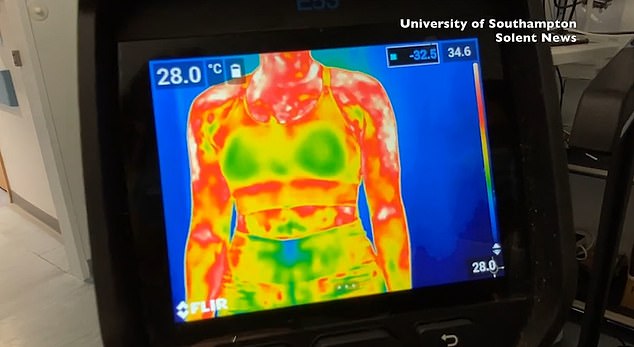Women with large busts may sweat less than their smaller-breasted counterparts, British sports scientist have found.
Researchers discovered the density of sweat glands reduces in line with breast size, which is the likely reason women with big boobs produced less moisture.
Meanwhile, less well-endowed women sweated more from the breast area, the study revealed.
The researchers said their findings couple help inform the design of sports bras for women of all sizes that better addressed ‘wetness, stickiness, support and chafing’ in order to stay comfortable.
To put their theories to the test, scientists at the University of Southampton studied 22 healthy women aged 18 to 55 with various breast sizes.


Researchers discovered the density of sweat glands reduces in line with breast size, which is the likely reason women with big boobs produced less moisture


3D scanning was used to calculate breast surface area, while sweat gland density was measured using iodine-infused paper which, when placed on the skin, reacts with the chemicals in sweat


Women with larger busts sweated less from the breast area, but the researchers found no distinct difference in amount of sweat produced under the arms, breast or body temperature between larger and smaller breasted women
They found women with the smallest breasts had up to 71 sweat glands per square centimetre, while those with the largest had as few as 10 glands across the same area.
Researcher Hannah Blount said: ‘More than 85 per cent of women deem a sports bra an essential piece of equipment for exercise, but it’s actually really hard to find one that’s comfortable and supportive, so a lot of women struggle with this.
‘Our thought process was to look at how sports bras offer support to women and comfort to women of varying breast sizes, especially in hot conditions when women are more likely to experience issues like chafing and significant sweat accumulation in the bra.
‘Specifically, we were interested in understanding how sweat gland densities and local sweat rates change across women of different breast sizes, as that determines how much sweat ends up in the sports bra.
‘Here we got the most exciting finding, as our results indicated that larger-breasted women have fewer sweat glands, and so they produce less sweat across their breast.
‘This fundamental knowledge is something we can now use to inform sportswear design that considers the needs of women of varying breast sizes.’
She added: ‘We’re becoming more sedentary as a society, so if we can do anything to aid women to become more active while making sport more accessible, then that’s really exciting.’
The body stops developing new glands by roughly the age of two.
The researchers said that as a girl’s breasts develop during puberty, sweat glands become less densely populated over the surface of her skin.
They also discovered that sweat glands do not output more sweat when they are fewer in number, meaning larger breasts produced less sweat overall.
Each of the 22 women in the study was asked to jog for 45 minutes in a warm climatic chamber at 32C.
The amount of sweat they produced across their breasts was monitored for sweat production in two places, above and below the nipple — and thermal cameras were used to check how much heat their bodies produced during the exercise.
Sweat production was also monitored under the arms.


New sweat glads stop developing in a human body by age of two. As a girl’s breasts develop during puberty, sweat glands become less densely populated over the surface of her skin
3D scanning was used to calculate breast surface area, while sweat gland density was measured using iodine-infused paper which, when placed on the skin, reacts with the chemicals in sweat.
Women with larger busts sweated less from the breast area, but the researchers found no distinct difference in amount of sweat produced under the arms, breast or body temperature between larger and smaller breasted women.
The experiments were conducted in the state-of-the-art climate chamber of ThermosenseLab, at the NIHR (National Institute for Health and Care Research) at University Hospital Southampton.
Dr Davide Filingeri, a leading expert in human skin wetness sensing, said: ‘Women undergo unique anatomical, physiological and hormonal changes across their lifespan.
‘Consider the impact of the menstrual cycle, pregnancy and menopause, all of which impact a woman’s heat tolerance, thermal sensitivity and comfort.
‘As such, Hannah’s research on the unique and evolving “thermal needs” of women’s bodies has the potential to inform person-centred innovation in sportswear, which will ultimately help women thrive in our warming climate.’
The study, published in the journal Experimental Physiology, said the number of women taking part in sport has increased considerably over the last 50 years, with data indicating almost 50 per cent of women worldwide are now interested in sport.
But a lack of suitable clothing can be a barrier to many women taking part in sport.
While sports bras that expose more skin may allow the breasts to radiate more heat, this may reduce their effectiveness in providing the required support.
Source: Mail Online






